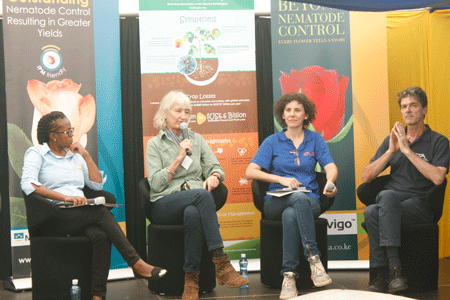
Syngenta East Africa held an impressive nematodes Management Field Day
Nematodes cause significant damage and lead to massive yield loss to a variety of crops often together with other pathogens. However, they are often overlooked or misdiagnosed, resulting in the use of unhealthy agrochemicals.
It’s at this juncture that Syngenta East Africa Limited, a company that has reached high echelons to bring ‘plant potential to life’ through innovative solutions to maximize yields, enhancing quality and limiting post harvest losses held a Nematodes Management Field Day on Friday 18th May 2018 at Interplant Roses (EA) Ltd, located in Flower Business Park, Naivasha.
The event saw presentations by International Institute of Tropical Agriculture (IITA), International Centre of Insect Physiology and Ecology (ICIPE) and Syngenta together with their partners, giving practical hands-on opportunity to growers to learn more about nematodes, their impact to the floriculture industry and their management.
Nematodes life cycle is divided into six stages; egg stage, four juvenile stages and adult stage. The duration of this stages and the complete life cycle differs for different species and depends on factors such as temperature, moisture and the host plant. They have a short life cycle, but during this time, one juvenile lays 300 to 500 eggs which leads to rapid population build up.
They invade plant tissue usually as newly hatched at second juvenile stage. They move through the soil to locate host roots and move through the plant tissue to locate a feeding site.According to Danny Coyne of the International Institute of Tropical Agriculture (IITA), nematodes damage roots tips.
“At the feeding site, the juveniles feed on relatively small number of cells, which are regulated by the nematode with growth substance. As they develop, their bodies swells to a spherical, lemon, kidney or void form,” Danny Coyne stated.
The pest is very tinny and can only be seen when one uses a micro-scope. The big sign of discovering they have invaded a farm is chlorotine, a state where a plant fails to absorb water leading to wilting.
Laura Cortada of the International Institute of Tropical Agriculture (IITA), avers that farmers need to get their soils tested by a reliable laboratory and always carry out routine checkups to ascertain the levels of infection if its heavy infestation or not before carrying out curative measures.
“Take a good soil sample 20-30 centimeters deep as they have a tendency of penetrating deep in the soil. They also have a patchy distribution and a grower needs to do a Zig-Zag pattern while obtaining the samples,” Cortada said.
Before carrying out a soil lab analysis, it’s advisable to first establish the history of the fields. “A quantity of 1-2 kilograms of soil sample should be extracted from the soil and be well stored in a cool place as nematodes easily de-hydrates,” Cortada opined.
Solveig Haukeland of the International Centre of Insect Physiology and Ecology (ICIPE) emphasized that it’s sagacious for growers to bring down the populations of nematodes by planting resistant crop varieties as well as adopting crop rotation.
“As a grower you need to plant quality seedlings, remove volunteer crops which act as alternate hosts, and use clean water. Water and cocopeat also act as intermediaries where nematode thrives. Use clean tools and limit soil movements in the farm,” she said.
Mary Njambi, Sygenta EA Technical Manager for the Lawn and Garden business,opined that the company has made tremendous strides as far as nematodes are concerned and they have a Tervigo a chemical product for controlling them.
“Tervigo is a proven against a variety of destructive nematodes in ornamental crops. Its unique chelated formulation ensures effective protection of the active ingredient for optimal soil penetration and contacts with nematodes leads to more vigorous and higher yielding crops,” Njambi stated.
Beyond its excellent nematode control, TERVIGO shows significant crop enhancement effects through increased root mass and greening effect on leaves and retails at a pocket friendly price in the market.

